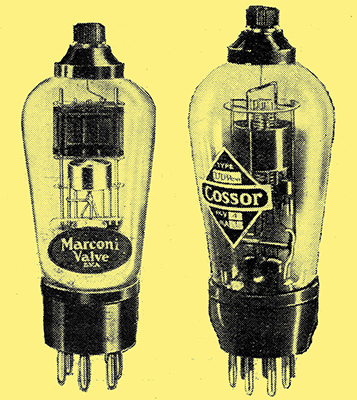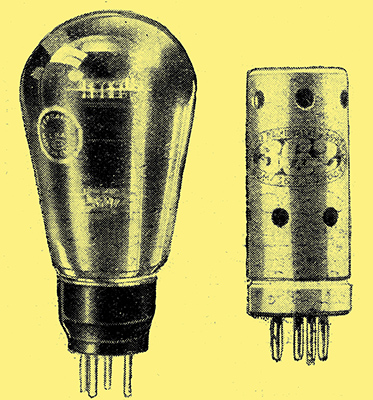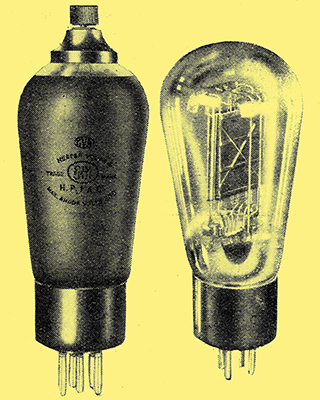|
The show portrays the growth of the multiple valve.

L-R: Marconi MHD4 duo-diode triode - Cossor DD/Pen duo-diode triode.
So rapid been the development of the multiple valve that it is still customary to think of it as a rarity and something of a curiosity. It comes as a surprise, therefore, to find that practically every valve firm is exhibiting at least one type, The duo-diode-triode is the most usual, and it consists essentially of three separate valves - two diodes and one triode - assembled in a single glass envelope with a common cathode and fitted to a seven-pin base.
The chief purpose of this valve is for providing signal rectification, delayed automatic volume control, and LF amplification in a simple and inexpensive manner. Generally, one diode is used as a detector for demodulation purposes, and the other as an over biased rectifier for providing the biasing voltage for delayed AVC, while the triode acts as a simple first stage LF amplifier. Many variations are possible, however, and the two diodes may be used to give push-pull detection with or without simple AVC; alternatively, one diode may give signal rectification and produce the steady voltage for biasing purposes, while the triode acts as an amplifier of both the LF voltages and the DC potential and the other diode provides the necessary delay action - this system is known as delayed amplified AVC.
Although a common cathode is provided for the different sections of the valve, the diode anodes are screened from the triode assembly and the grid connection of the latter is brought out to a terminal at the top of the bulb in order to minimise common coupling between the different circuits. So far the duo-diode-triode is available chiefly in mains types, and the AC model is by far the commonest. The Ferranti H4D, the Marconi MHD4, the Mazda AC/HLDD, the Osram MHD4, the Six-Sixty 4DDTAC, and the Micromesh and Mullard specimens are all of the AC type, but Marconi and Osram have a DC model, the DHD, with a heater rated at 20 Volts 0.25 ampere, and Mullard have a type with a heater designed for operating at 25 Volts 0.18 Ampere.
In the battery range Mazda are showing the first battery duo-diode-triode, the L2DD, the triode portion having an AC resistance of 10,000 Ω with a mutual conductance of 1.6 mA/V.
Mullard have also a single-diode-tetrode in their AC range, and as its name implies, this consists of the combination of a single diode with a screen-grid valve, Although the primary purpose of this valve is to replace the ordinary screen grid detector, it is by no means improbable that one of its chief applications will be found in conjunction with the duo-diode-triode to provide quiet delayed automatic volume control.
The Cossor multiple valve is a duo-diode-pentode, the pentode portion being a screened variable-μ pentode. The diode system is intended to give signal rectification with delayed AVC, but the bias voltages are also applied to the control grid of the pentode which acts as the first LF amplifier. AVC thus operates on both pre-detector and post-detector stages, and it is claimed that this results in a practically perfect control.
Class B Ranges
No description of multiple valves would be complete without the inclusion of the Class B types, for these really consist of two triodes mounted in the same bulb. In most cases they are operated with zero grid bias, and their chief virtue is extreme economy in battery power while providing quite large volume with good quality. Cossor have two types, the 220B, rated for an output of 1 Watt, and the 240B, rated for 2 Watts, while Ferranti, Mullard, and Six-Sixty all list specimens. The Mazda PD220 is unusual in that it is operated at zero bias with normal anode voltages, but requires a very small negative grid bias when its full rated voltage is applied. The B21 type of both Marconi and Osram, however, requires an appreciable bias with all anode voltages, and under its maximum rated conditions it needs from 4½ to 6 Volts, and it is then capable of an output of 2 Watts. These valves are claimed to have an unusually high input impedance and to be free from parasitic oscillation.
Turning from the multiple types, we find a new class of multi electrode valves, the foremost of which is undoubtedly the Ferranti heptode, for it has no less than seven electrodes. The valve is of the Pentagrid type, and fulfils the functions of a variable-μ first detector valve and separate triode oscillator for superheterodyne frequency changing purposes. Next in order come the HF pentodes. These are essentially similar to the ordinary screen grid types, but include an additional electrode, the chief function of which is to increase the voltage handling capacity of the valve. As a result, overloading is less likely to occur than with older valves, and the benefit of this change is most noticeable in a battery set where the HT supply is usually limited. So far the variable-μ battery HF pentode has appeared only in the Marconi and Osram ranges.
Cossor, Ferranti, Marconi, Mazda, Micromesh, Mullard, Osram, and Six-Sixty all have HF pentodes in their AC mains ranges, and most firms are marketing them in both ordinary and variable-μ types. The latter is the more generally useful for amplification purposes, of course, and the non-variable-μ models are chiefly for detector oscillators and detectors. Most firms, too, are now making indirectly heated rectifier valves for the HT supply.

L-R: Ferranti LP4 2½ Watt triode - 362 Toledo battery valve.
The introduction of Class B working has given a new lease of life to the battery set, and so stimulated improvements in battery valves. Both Marconi and Osram have introduced several low consumption screen-grid valves, and the 362 Radio Valve Co. are showing the Toledo range of unbreakable battery valves with a metal construction. In the AC type Marconi and Osram Catkin valves now replace the ordinary types of the same list numbers, but have not yet been further extended.
Mullard have brought out a large triode output valve, the DO26, rated for 400 Volts and rated for 25 Watts anode dissipation, while Marconi and Osram have a 16 Watts pentode, the PT16, which is of the directly heated type. Mazda have a new pentode rated for 250 Volts anode and screen supplies which is capable of giving an output of nearly 3½ Watts with a signal input of only 2.6 Volts RMS This is the type AC2/Pen.

L-R: Six-Sixty HP1AC HF pentode - Mullard DO26 output triode.
Although not strictly speaking valves, the Westinghouse metal rectifiers are conveniently classed as such, since they can replace the diode for signal rectification and AVC purposes. Two types are available, each in a single or push-pull model, with different input voltage ratings.
It will thus be apparent that there are two distinct trends visible in valve design - that towards multiple valves, and that towards multi electrode valves. The former is exemplified by the combination diode types and the Class B valves, whereas the latter is brought out in the heptode and pentode types. Each system may have its practical merits, but there is no doubt that the multiple valve is less interesting technically than the multi electrode type, for it may always be replaced by a suitable number of ordinary valves, and it involves no new principles. The multi electrode valve, however, represents a distinct advance, for its performance cannot be duplicated by any combination of ordinary types.
|